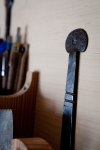Why You Should Work With a Blacksmith –

Yesterday I put the finishing touches on my traveling Dutch tool chest: strap hinges and a hasp made by John Switzer of Black Bear Forge.
Of course, the metalwork looks fantastic and correct on this old-style piece. But beyond the outward appearance, these hinges reminded me of why it’s always nice to work with a blacksmith on a furniture project.
First, I was able to get straps and a hasp that were perfectly scaled to the piece. I couldn’t find manufactured straps that had leaves where both were the lengths I wanted.
Also, Switzer was able to make the hinges and hasp so they worked perfectly with my lid, which is at a 30° slope. The hasp comes down at 30° and stops just where it should. The hinges lift up just past 90° and stop – I don’t need a chain or leather strap to prevent the lid from flipping back.
Switzer also supplies slot-head screws that are exactly the same color as the hardware. So installing all the hardware on this chest took about 30 minutes – instead of a whole day of stripping, cleaning, grinding, filing and tweaking to get commercial stuff to fit and suit my (admittedly) picky tastes.
And the price was fair for this level of work – $260 delivered for the two hinges and hasp.
Having this chest complete is a huge relief – I drive to Highland Hardware in Atlanta on Thursday for the Lie-Nielsen Hand Tool Event and to teach a one-day class. If you’re in the area, come by and check out the chest and hardware – plus I’ll bring my Milkman’s Workbench.
And if you need some custom iron hardware, I can highly recommend Switzer. I’ll be knocking on his digital door again real soon.
— Christopher Schwarz
P.S. Before I forget: This Dutch chest – fully loaded – tips the scales at 98 pounds, or about 44-1/2 kilograms for our metric friends.










